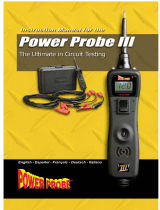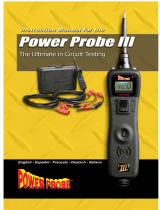Page is loading ...

User Manual
•Mode d’emploi
•Bedienungshandbuch
CT235A, CT237A
AC/DC Current Probes

CT235A, CT237A
AC/DC Current Probes
User Manual
• Mode d’emploi
• Bedienungshandbuch
PN 1566220
March 2007
©2007 Amprobe Test Tools.
All rights reserved.

CT235A, CT237A
AC/DC Current Probes
User Manual
English

Limited Warranty and Limitation of Liability
Your Amprobe product will be free from defects in material and
workmanship for 1 year from the date of purchase. This warranty does
not cover fuses, disposable batteries or damage from accident, neglect,
misuse, alteration, contamination, or abnormal conditions of operation
or handling. Resellers are not authorized to extend any other warranty
on Amprobe’s behalf. To obtain service during the warranty period,
return the product with proof of purchase to an authorized Amprobe
Test Tools Service Center or to an Amprobe dealer or distributor. See
Repair Section for details. THIS WARRANTY IS YOUR ONLY REMEDY. ALL
OTHER WARRANTIES - WHETHER EXPRESS, IMPLIED OR STAUTORY -
INCLUDING IMPLIED WARRANTIES OF FITNESS FOR A PARTICULAR PURPOSE
OR MERCHANTABILITY, ARE HEREBY DISCLAIMED. MANUFACTURER
SHALL NOT BE LIABLE FOR ANY SPECIAL, INDIRECT, INCIDENTAL OR
CONSEQUENTIAL DAMAGES OR LOSSES, ARISING FROM ANY CAUSE
OR THEORY. Since some states or countries do not allow the exclusion
or limitation of an implied warranty or of incidental or consequential
damages, this limitation of liability may not apply to you.

1
AC/DC Current Probes
Contents
Warnings and Precautions ........................................................................... 1
Symbols ......................................................................................................... 1
Introduction .................................................................................................. 1
Specifications ................................................................................................ 2
Electrical data ............................................................................................ 2
General data .............................................................................................. 2
Operating Instructions ................................................................................. 3
Switch On ................................................................................................... 3
Zero Adjustment ........................................................................................ 3
Current Measurement ............................................................................... 3
Safety ............................................................................................................ 3
Battery Replacement .................................................................................... 3
Frequency Response and Accuracy Curves .................................................. 4
Repair ............................................................................................................ 4
Warnings and Precautions
PLEASE READ SPECIFICATIONS BEFORE OPERATING THE INSTRUMENT
Exceeding the maximum limits of this instrument is DANGEROUS. Exceeding
these limits will expose you to physical injury or even death and will almost
certainly damage your instrument. Even low-level voltages and currents are
capable of causing serious injury or even death.
• Please do not use this or any piece to test equipment without proper
training.
• Individual functions and ranges have different overload limits.
• It is VERY IMPORTANT that you make yourself aware of these overload
limits.
• Check the specifications of these overload limits.
Symbols
Caution! Refer to this manual before using the probe.
Probe is protected by Reinforced or Double Insulation.
Application around and removal from HAZARDOUS LIVE
conductors is permitted.
Introduction
The CT235A and the CT237A current probes have been designed for use with
digital multimeters, recorders and other suitable equipment for accurate
non-intrusive measurement of AC, DC and complex waveform currents. Using
advanced Hall Effect technology the CT237A can accurately measure currents
up to 200 A rms over the frequency range of DC to 10 kHz, while the CT235A
measures currents up to 1000A DC or AC peak. These features make them
powerful tools for use in inverters, switch mode power supplies, industrial
controllers, automotive diagnostics and other applications requiring accurate
isolated current measurement.

2
Specifications
Electrical data
(All accuracies stated at 23°C ± 1°C)
Current ranges
CT237A 20A and 200A DC and AC r.m.s.
CT235A 200A and 1000A DC and AC peak
Overload capacity 1000 %
Overall accuracy
CT237A, 20A range DC ±1% of rdg ± 0.03A
20A range AC, <5kHz ±1% of rdg ± 0.03A
5kHz to 10kHz ±2% of rdg ± 0.03A
CT237A, 200A range DC ±1% of rdg ± 0.3A
200A range AC, <2kHz ±1% of rdg ± 0.3A
2kHz to 5kHz: ±2% of rdg ±0.3A
5kHz to 10kHz: ±5% of rdg ±0.3A
CT235A, 200A/1000A range, DC ±1% of rdg ± 0.5A
200A/1000A range, AC, <10kHz ±1% of rdg ± 0.5A
Resolution
CT237A, 20A range ± 10mA
CT237A, 200A range ± 100mA
CT235A, 200A range ± 100mA
CT235A, 1000A range ± 100mA
Temperature coefficient ± 0.1% of reading/°C
Output sensitivity
CT237A, 20A range 10 mV/A
CT237A, 200A range 1mV/A
CT235A, 200A range 1 mV/A
CT235A, 1000A range 1 mV/A
Frequency range ( -1dB) DC to 10 kHz (limited by eddy current
heating for Irms x f >400,000)
Dielectric strength 3.7kV r.m.s. 50 Hz for 1 min
Safety: Meets EN61010-1 Cat III 300V; EN61010-2-032
EMC: Meets EN50081-1, EN50082-1
EMC: This product complies with requirements of
the following European Community Directives: 9/336/EEC (Electromagnetic Compatibility)
and 73/23/EEC (Low Voltage) as amended by 93/68/EEC (CE Marking).
General data
Operating temperature 0°C to +50°C
Storage temperature with battery removed
- 20°C to +85°C
Power supply 9 V, Alkaline battery
PP3, NEDA 1604 or IEC6F22
Battery life 50 hours typical
Load impedance (minimum) >10 k and ≤100pF
Conductor size
CT237A 19 mm
CT235A 31 mm
Jaw opening
CT237A 20 mm max.
CT235A 32 mm max.
Weight
CT237A 250 g.
CT235A 295 g.
Output cable and connectors 1.5 m long terminated with 4mm safety
plugs
Environmental
- indoor use
- altitude up to 2000m
- temperature 0°C to +50°C
- maximum relative humidity 80% for temperatures up to 31°C decreasing
linearly to 40% relative humidity at 50°C.

3
Operating Instructions
Refer to Fig. 1. When the probe is switched on the red LED will illuminate. If
the LED starts flashing this warns the user that the battery voltage is too low
for normal operations and that it should be changed as described in Battery
Replacement.
Switch On
When the probe is switched on, the red LED will illuminate. If the LED starts
flashing this warns the user that the battery voltage is too low for normal
operation and that it should be changed as described in Battery Replacement.
Zero Adjustment
The output zero offset voltage of the probe may change due to thermal shifts
and other environmental conditions. To adjust the output voltage to zero
depress the thumbwheel and rotate. Ensure that the probe is away from the
current carrying conductor when the adjustment is made.
Current Measurement
Switch on the probe using the On - Off switch and check that the LED is lit.
Select the required current range (20 Amp or 200 Amp for the CT237A; 200A or
1000A for the CT235A).
Connect the output lead to a multimeter. Select AC millivolts to measure
Alternating Current and DC millivolts for Direct Current. Autoranging meters
will automatically select the correct range.
If necessary adjust the probe output voltage to zero as described in Zero
Adjustment. Clamp the jaws of the probe round the conductor ensuring a good
contact between the closing faces of the jaws.
Observe and take measurements as required. Positive output indicates that the
current flow is in the direction shown by the arrow on the probe. Multiply the
reading dependent upon the range you are in. See Output sensitivity in the
Specifications section for conversion.
True r.m.s. readings can be obtained by using an appropriate true r.m.s. reading
multimeter. Core eddy current heating is produced when Irms x f >400,000.
Safety
Use of the probe on uninsulated conductors is limited to 300V r.m.s or d.c. and
frequencies below 1kHz.
Safety in its use is the responsibility of the operator who must be a suitably
qualified or authorized person.
Do not use the probe if any part of the probe including the lead and
connector(s) appear to be damaged or if a malfunction of the instrument is
suspected.
When using the probe ensure that your fingers are behind the protective
barrier see Fig. 1
Clean the case periodically by wiping it with a damp cloth and detergent. Do
not use abrasive cleaners or solvents. Do not immerse the probe in liquids.
Battery Replacement
Warning
Before removing the battery cover, make sure that the probe is remote from
any live electrical circuit.
The red LED will flash when the minimum operating voltage is approached.
Refer to Fig.1. and use the following procedure.
1. Unclamp the probe from the conductor, turn it off using the
On - Off
switch and disconnect the output leads from external equipment.
2. Loosen the captive screw which secures the battery cover.

4
3. Lift the cover through 30° and pull it clear of the probe body as shown in
Fig 1. The battery is then accessible.
4. Replace the battery and re-fit the battery cover and fasten the screw.
5. Replacement with other than the specified type of battery will invalidate
the warranty. Fit only Type 9 V PP3, Alkaline (MN 1604).
Frequency Response and Accuracy Curves
Refer to Fig. 2.
Repair
All test tools returned for warranty or non-warranty repair or for calibration
should be accompanied by the following: your name, company’s name, address,
telephone number, and proof of purchase. Additionally, please include a
brief description of the problem or the service requested and include the test
leads with the meter. Non-warranty repair or replacement charges should be
remitted in the form of a check, a money order, credit card with expiration
date, or a purchase order made payable to Amprobe® Test Tools.
In-Warranty Repairs and Replacement – All Countries
Please read the warranty statement and check your battery before requesting
repair. During the warranty period any defective test tool can be returned to
your Amprobe® Test Tools distributor for an exchange for the same or like
product. Please check the “Where to Buy” section on www.amprobe.com for
a list of distributors near you. Additionally, in the United States and Canada
In-Warranty repair and replacement units can also be sent to a Amprobe® Test
Tools Service Center (see address below).
Non-Warranty Repairs and Replacement – US and Canada
Non-warranty repairs in the United States and Canada should be sent to a
Amprobe® Test Tools Service Center. Call Amprobe® Test Tools or inquire at
your point of purchase for current repair and replacement rates.
In USA In Canada
Amprobe Test Tools Amprobe Test Tools
Everett, WA 98203 Mississauga, ON L4Z 1X9
Tel: 877-AMPROBE (267-7623) Tel: 905-890-7600
Non-Warranty Repairs and Replacement – Europe
European non-warranty units can be replaced by your Amprobe® Test Tools
distributor for a nominal charge. Please check the “Where to Buy” section on
www.amprobe.com for a list of distributors near you.
European Correspondence Address*
Amprobe® Test Tools Europe
P.O. Box 1186
5602 BD Eindhoven
The Netherlands
*(Correspondence only – no repair or replacement available from this address.
European customers please contact your distributor.)

CT235A, CT237A
AC/DC Current Probes
User Manual
• Mode d’emploi
• Bedienungshandbuch
French
Francais

CT235A, CT237A
AC/DC Current Probes
Users Manual
• Mode d’emploi
• Bedienungshandbuch
German
Deutsch
/


